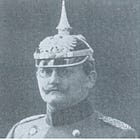Tactics that make use of this “pincer principle” are called combined arms tactics. Such tactics use two tactical actions (the “arms”), each of which alone is relatively weak, and combine them to put the enemy in a situation where he is “damned if he does, and damned if he doesn’t.”
The simplest form of combined arms tactics is the crossfire. Consider the case of an enemy rifleman shooting at us from behind a tree. If we fire at him only from the front, he is protected by the tree. If we go around him and start firing from his rear, he can go to the other side of the tree and still have the same degree of protection. If, however, there are two of us and one fires at the enemy rifleman from the front and the other fires at him from the rear, we have put him in a dilemma. If he faces to his front, he exposes his unprotected back. If he faces to his rear, he exposes his back to someone else. Whatever he does, he is vulnerable.
The devastating nature of a crossfire is well illustrated by the experience of the French Lieutenant André Laffargue, who was caught in one in the opening days of World War I. On the 20th of August 1914, a Laffargue’s company found itself at the foot of a small draw. As the Frenchmen moved forward up the draw, small groups of German riflemen infiltrated among the trees on either side of the draw. When the horseshoe was complete, the Germans opened fire. With his men dying around him, Laffargue tried to attack into the ambush. He formed his men into a skirmish line and charged farther up the draw. The closer the Frenchmen got to the top of the draw, however, the more they exposed themselves to the German crossfire.
True to their peacetime training, the surviving Frenchmen knelt and began returning fire. After a few more minutes, however, the cohesion of the French platoon broke down. As a result of the predicament in which they found themselves, the unit of soldiers degenerated into a mass of individuals concerned more for their own survival than the accomplishment of their mission. Without orders, the French started to withdraw. Within a few minutes, the unauthorized withdrawal had turned into a route. Laffargue found himself alone in the crossfire, convinced that not only the battle but the entire war was doomed to failure. “It was”, he later recalled, referring to France’s defeat in the Franco-Prussian War, “1870 all over again.”
Source: The description of the French company caught in a crossfire comes from André Laffargue, Fantassin de Gascogne. De mon jardin à la Marne et au Danube. (Paris: Flammarion, 1962), pages 59-78.
Other parts of this article:







Rather amazing that Lieutenant Laffargue survived to tell this tale.
As in chess; seeking to create a dilemma for your opponent.